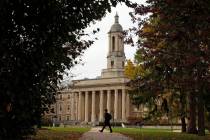There’s still a lot to learn about Nevada’s new Education Savings Accounts
The questions about Nevada’s new Education Savings Accounts keep coming. And at this point, a lot of them can’t be answered.
Over the past few weeks, I’ve written about ESAs, the state’s mold-shattering school choice law that gives Nevada families more educational options than they’ve ever had before. Parents who aren’t satisfied with the education provided by public schools will be able to withdraw their children and gain control of the state funding that supported their enrollment. Starting in January, low-income families and households with disabled children can qualify for about $5,700 per year per child that can be spent on private school tuition, tutoring, distance learning, technology and other authorized expenses. All other families can qualify for about $5,100 per child per year.
Although a lot of questions can be answered by reading the law, the details of the program’s operation haven’t been settled. The state treasurer’s office will administer the program, and its staffers are working on the regulations and procedures as I write this. Those regulations will provide definitive answers to a lot of the questions families have. But that doesn’t mean I can’t provide opinions — based on my interviews with lawmakers and state officials — on how things might look by next year, when parents should be able to start opening the accounts.
Q: How will parents access ESA funds?
A: It’s a near-lock that parents who apply for ESAs will be given electronic benefit transfer cards. The funds likely will be made available on those EBT cards either quarterly — when the state transfers money from the Distributive School Account to school districts and charter schools — or perhaps as frequently as monthly.
Q: How will the state prevent parents from squandering tax dollars on noneducational expenses?
A: Fraud prevention will be as important as any part of administering ESAs. School choice is, generally speaking, a Republican cause, and Republicans are quick to condemn welfare fraud and abuse. If ESAs wind up funding drinking binges at casinos and nightclubs, there will be calls to shut the whole thing down, regardless of how much good ESAs do for families currently stuck with lousy schools.
Fraud prevention is another reason why EBT cards are an obvious choice for fund distribution. EBT cards, if managed properly by a financial institution, won’t cover unauthorized expenses. For example, EBT-administered food stamps aren’t supposed to pay for alcohol or tobacco at grocery stores. However, a simple Google search for “EBT fraud” turns up hundreds of thousands of hits. One obvious step the treasurer’s office must take: making sure ESA EBT cards can’t be used at ATMs to collect cash.
The law requires audits of ESAs and empowers the treasurer to freeze or close an account that shows “substantial misuse” of state dollars.
Q: Can parents open an ESA for a student who will be home-schooled?
A: The law says no, but this provision will be difficult to enforce. Why? The law requires that students receive instruction from a “participating entity,” such as a private school, distance learning program or an accredited tutor. But do you know who else is listed as an authorized “participating entity”? “The parent of a child.” That seems like an intentionally large loophole — the law guarantees independence to participating entities and ESA funds can be used to buy curricula, textbooks and technology. What exactly would a parent who buys materials do as a “participating entity” besides provide home-schooling? The treasurer should try to clarify what parents can and cannot do.
Q: Can parents use ESAs to send their children to private schools or educational programs outside the state?
A: No. On this, the language of the law leaves no doubt. The student has to live in Nevada and receive instruction here. But I find it silly that it’s OK for a student to participate in distance learning — instruction provided online from somewhere else — but not actually be somewhere else. Why shouldn’t a parent be able to use an ESA to send a child to a math or science camp? Perhaps one day, lawmakers can change that.
Q: If a parent tries an ESA, but it doesn’t work for the child, can that child re-enroll in public school?
A: Yes. The law allows it. The treasurer’s office will have to create policies on how soon the child can re-enroll — especially if a parent has spent all of the child’s ESA funds. After all, that’s state money that would have been used to fund public school enrollment. The certainty that some children will return to public schools is an argument for monthly ESA distributions, so funding is available for an unanticipated re-enrollment in a school district.
If a family opens an ESA, then returns to public school, that family can open an ESA again at some point in the future.
Glenn Cook (gcook@reviewjournal.com) is the Las Vegas Review-Journal’s senior editorial writer. Follow him on Twitter: @Glenn_CookNV.




























